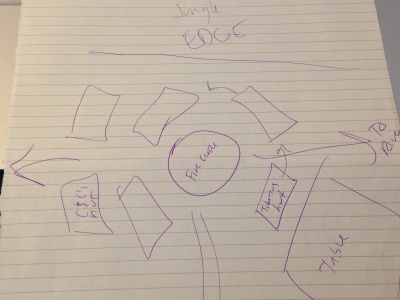In case you missed my last blog post, I mentioned one of my future projects is a fantasy series called the Ozais series. I have a first draft written for the first book, and I am really excited about the book. The series originated from a recurring dream I had as a kid. In the dream, my house and neighborhood was under water so we had to canoe from house to house. (Somehow the houses weren't flooded). Anyways, I used this water idea to develop a unique setting for the series. As I wrote the first book, I found myself having to stop to straighten out details and settings unique to the fantasy setting. If I had more foresight, I would have outlined and planned beforehand. (But where's the fun in that?)
For anyone who may be writing a fantasy novel or want to write a fantasy novel, here are a few tools I used to create a fantasy world on the fly.
Maps & Diagrams
My setting is one of the most interesting and complex aspects of the Ozais setting. Although I'm not artistic (see below), I cracked open my notebook and started drawing. They are not works of art, but they help me greatly. If I can picture where a place is and how to get from place A to place B, writing the story becomes easier. I plan on redoing many of these maps and diagrams before I revise the first draft.

Setting Descriptions
Along with the maps and diagrams, I also wrote out detailed descriptions of the various places in my world. Besides writing a physical description of the terrain and weather, I listed the people who lived there and why.
Character List
I usually create a character list for my projects. However, it's usually a one page document with the important names listed and a few defining characteristics. For my contemporary YA, I can keep the characters appearance and personality straight in my head, so I don't need to reference it often.
For the Ozais, I created a document for each major character in the story. Since we meet some characters early in the first book, but we won't see them again until book 2, I needed more details. Plus, there are more characters and it's much more complex. The character sheets make sure my brain doesn't implode with too much information.
Magic System
The magic system in fantasy novels can make or break it. It needs to be clear and make sense in the context of the world you created. This is tricky. I found thinking and planning in terms of cause and effect is beneficial. If my character can do this, what effect does her power have on others? What effect does it have on the world? Why can she do this special thing?
I don't have a specific plan to help you create a magic system, but in my opinion, ask lots of questions and answer them.
Timeline
Finally, I created a timeline for my world. In the timeline, I listed everything that happened day by day during the novel. I also wrote notes on what happened before and after the first book took place. I will continue to add to the timeline. Eventually, it might hang on my wall above my office for reference. Timelines are awesome.
By the way, my timeline is different than an outline. My outline was written before the book was written. For me, the outline tells the general steps the characters take to advance the plot. It allows for flexibility and some improvisation. I put together the timeline as I write the book so I can refer back to it. For a timeline example, this character punched that guy on this day, then he took a nap. Two characters get into an argument would be the outline example.